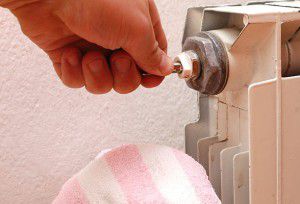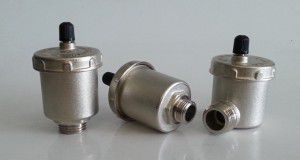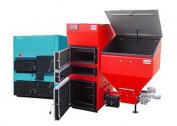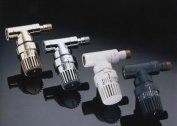There are frequent cases when radiators suddenly stop heating during the heating season. One of the reasons for the failure of the system is an air congestion, and then the problem arises for the residents, how to bleed air from the heating battery in order to restore circulation. There are several effective ways to normalize heating and how to bleed air from the system. In this case, the procedure should be determined depending on the type of heating system and the specific place of air accumulation.
Air plug appearance
It is easy enough to find out that an air congestion has formed in the heating system. Signs of airing system:
- gurgling sounds are occasionally heard in pipes and radiators;
- batteries either do not heat at all, or only half heat up;
- in some rooms it’s hot, while in others the heat does not pass.
This means that the accumulated air is to blame for everything, and how to lower it from the heating system must be decided in accordance with exactly where it accumulated. Air bubbles always accumulate in the upper part of the heating system, so most often radiators cool in rooms on the top floor. To find the location of the air plug, you need to consistently feel the supply pipe and all the batteries, checking the degree of heating. It is also advised to tap the pipes with a hammer and determine by the sound where a void appeared, but this must be done carefully so as not to damage the paint layer on the pipes.
As a result, having found a problem place, it is already possible to choose a method how to bleed air from a heating radiator or, if necessary, from a pipeline.
The air plug not only interferes with the circulation of the coolant, but also provokes corrosion of metal pipes. The presence of air in the system also negatively affects the operation of the circulation pump.
Where does the air in the system come from?
The causes of air congestion can be both natural and associated with improper system design and poor installation.
Naturally occurring causes:
- when the coolant is heated, the air dissolved in the liquid is released, it rises up and forms a cork;
- gas bubbles appear during the interaction of the hot fluid with certain types of metals (in particular, aluminum);
- due to evaporation, the liquid level in the open expansion tank decreases below a critical value;
- air does not have time to completely exit the pipes and batteries when filling the system with a complex configuration too quickly.
It is important to know how to drain the water from the heating system if necessary and then fill it again so that there is no air left in the pipes and radiators.
In addition to natural causes, the appearance of air jams also leads to:
- improper wiring of horizontal pipes and the installation of radiators;
- pressure drops in the feed water supply;
- poorly sealed compounds;
- deterioration of old pipelines;
- expansion tank malfunction.
When it turns out during the operation of the heating system that it was originally designed incorrectly, you will have to redo it. But in order to urgently restore the heat supply, you need to decide how to bleed air from the heating system.
Air plug elimination
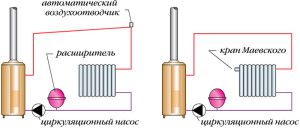
If the heating is correctly designed, then how to bleed air from it will not be difficult. It can be arranged so that the bleeding of the accumulated air will occur automatically, as it accumulates. For this, special devices are used - air vents installed at critical points. In other cases, it is necessary to acquire skills on how to bleed air from the heating system in manual mode.
It matters:
- open or closed type of system;
- natural or forced circulation of the coolant;
- upper or lower pipe layout;
- Are pipe slopes observed horizontally?
Radiator drain cock
In apartment buildings, residents do not have the question of how to bleed air from the heating, specialists of the management company should worry about this. Although the heating is arranged in the old five-story buildings, it is possible to bleed air out of it only through a radiator in the apartment on the top floor, and the residents themselves have to do this periodically. The airing problem for owners of private houses with autonomous heating looks more acute - it may be necessary to bleed air periodically. To bleed air from a radiator of water heating, a needle air valve, the so-called Mayevsky crane. Such a device is installed in the upper end of the radiator battery, instead of a plug. Sometimes it is also used to bleed air from a heated towel rail pipe. Different models of Mayevsky taps are slightly different, so before you bleed air in heating radiators, you need to read the instructions. Open the valve valve or open-end wrench, or a conventional screwdriver, or simply by hand.
Consider how to lower the air plug from the heating battery using the Mayevsky crane installed on it:
- prepare tools (wrench or screwdriver) and a container for collecting water;
- open the thermostat completely, then unscrew the Majewski tap half a turn;
- air will begin to escape through the valve with a slight hiss;
- substitute the container and keep the valve open, as it is necessary to bleed air from the heating radiator until water flows;
- when a dense stream of water appears, you can turn on the tap.
If after you blew air from the heating battery, it still does not heat up well, drain another 200 grams of coolant through the same tap to completely remove the air lock.
Air vent through expansion tank
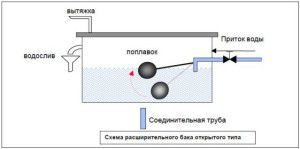
In private homes, the arrangement of heating systems is different, it depends on the particular layout of buildings. For different types of systems, appropriate expansion tanks are used - open or closed. Therefore, individual homeowners often have to think about how it is more appropriate to bleed air from a heating radiator or through an expansion tank.
In an open type system, air bubbles have free access through an expansion tank installed in the attic. If heating works normally, there is no need to bleed air from the system, since it exits itself. But the liquid gradually evaporates, and the water level in the open expansion tank can drop so low that an air plug appears in the upper part of the supply pipe. In this case, the circulation of the coolant will slow down or completely stop, and in this situation we should already be talking about how to bleed air from the heating system.
In order to drive out the air plug, you can add water to the expansion tank from above, but it is better to replenish the volume of fluid in the system through a lower tap connected to the water supply. Water coming from below will fill the void in the pipe and squeeze air out through the opening of the expansion tank.
During the heating season, it is necessary to ensure that the expansion tank is constantly filled with water by about 2/3 of the volume, and when the level drops, add water.
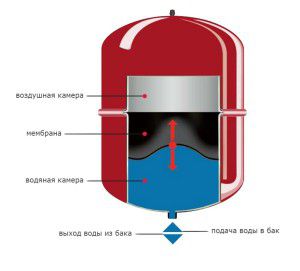
In closed systems, membrane expansion tanks are used. Sometimes they break the membrane, and then air enters the system. If it is possible to establish that the cause of the airing is a faulty expansion tank, it will have to be replaced. But before starting the repair, before flushing the water from the heating system, you need to prepare everything you need so as not to leave the house for long without heat.
What should be the correct device system
When designing, it should be provided that air can accumulate in horizontal pipes, and how to lower it from the heating system will not be an easy task. Therefore, it is important that the top feed pipe has a slight slope, starting from the riser and further along the flow of the coolant. At the highest point, a device is installed that allows the air to be removed from the heating. It can be a regular tap or a Maevsky tap, but it is better to use an automatic air vent. In a more complex heating system, air vents are mounted in all places where a problem of air supply can occur. Then the question will not arise how to bleed air in one or more heating radiators, since the accumulating bubbles will be gradually bleed out from each group of the components of the system.
The return pipe must be laid with a slope towards the boiler. This is done to combat air congestion, and also in order not to have to guess how to drain the heating system if repairs are necessary.
If the heating system is equipped with a circulation pump, then there is no need to observe the pipe slope with great accuracy. And yet, for the effectiveness of the system, it is desirable to lay pipelines with the correct slope.
In the end, we can always recommend contacting specialists about heating problems. They know how to design a workable system and advise on how to bleed air that has accumulated in heating radiators. But on the eve of the heating season, homeowners themselves must conduct a routine inspection and verification of their heating system.
The video gives a clear explanation of how to bleed air from a heating battery:


